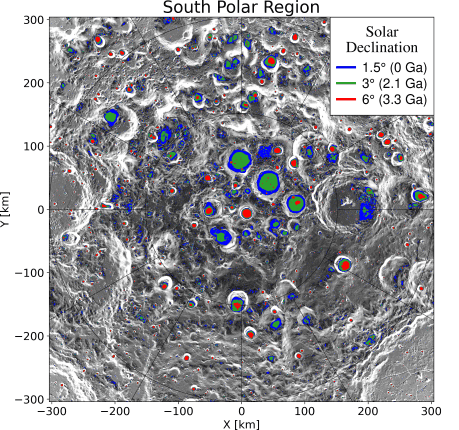
New estimates by planetary scientists in the US suggest that the Moon contains significantly less water ice than was previously thought. As well as providing insights into the Moon’s history and composition, the findings have implications for plans to establish a long-term human presence on the lunar surface or use the Moon as a base for crewed missions to other solar-system bodies.
Unlike Earth, the Moon is not crowned by ice caps at each pole. Instead, water from comet impacts and other sources accumulates in permanently shadowed regions (PSRs) that lie inside thousands of large and small craters. These PSRs are some of the coldest places in the solar system, and they are concentrated at the Moon’s poles, where sunlight strikes the lunar surface at a shallow angle of just 1.5 degrees.
Billions of years ago, though, the Moon’s axis was far more tilted – perhaps by as much as 77 degrees. This extreme axial tilt exposed the poles to harsh sunlight, eliminating PSRs and causing any previously-accumulated ice to sublimate into gas.
The cause of the Moon’s tilt, and the reasons why it disappeared, are relatively well-understood. “The Moon formed close to the Earth 4.5 billion years ago by a collision of a small planet with the early Earth, and has since migrated outward,” explains Norbert Schörghofer, a senior scientist at the Planetary Science Institute in Hawaii and co-author of a paper in Science Advances on the research. “Early on, it was more under the influence of tidal forces from the Earth, but now the tides from the Sun play a larger role, and this transition forced a reorientation of the lunar axis.”
The main unanswered question was when this transition happened. An early date would mean that some of the water the Moon gained or outgassed during its formation might still be there, locked away in craters. A later one would imply that nearly all this early water was lost to space.
New evidence, new picture
Until recently, the history of the Earth-Moon distance was not known well enough to estimate the transition date with any certainty. In 2022, however, astronomers at France’s Observatoire de Paris resolved longstanding discrepancies between geochemical data and physical models of tidal interactions. Their improved model allowed Schörghofer and co-author Raluca Rufu of the Southwest Research Institute in Boulder, Colorado to plot the lunar tilt as a function of time – and that, together with surface height measurements from the Lunar Orbital Altimeter Laser (LOLA), enabled them to calculate how much ice exists in today’s PSRs.

These calculations reveal that the oldest PSRs formed no more than 3.94 billion years ago, making water ice on the Moon considerably younger and thus much less extensive than previous studies suggested. “The overall estimates for the amount of water ice that can be expected have to be revised downward dramatically,” Schörghofer tells Physics World. He adds that Kevin Cannon, a geologist at the Colorado School of Mines who maintains a list of promising lunar mining and landing sites, has already started to update estimates of the Moon’s water ice based on the new findings. According to him, Schörghofer says, “deposits of nearly pure ice tens to hundreds of metres thick are no longer expected”.
The outlook for would-be lunar water prospectors isn’t entirely negative, though. “We now have more accurate maps for where the largest concentrations of ice can be expected on the Moon,” Schörghofer notes. “This can be extremely helpful for the selection of landing sites.”

Satellites find water on the Moon
Schörghofer adds that in a previous study, he, Paul Hayne of the University of Colorado, Boulder and Oded Aharonson of Israel’s Weizmann Institute of Science found that PSRs were more widely distributed than expected. While the new work with Rufu shortens the maximum age of PSRs, it also shows that PSRs as young as 0.9 billion years – which are typically smaller than older PSRs due to the smaller size of the craters that harbour them – can still contain ice. “Overall, we expect less ice, but at more places,” he concludes.
In the future, Schörghofer and colleagues hope to refine their ice estimates by calculating the exact temperatures in shadowed craters such as Cabeus, which NASA’s Lunar Crater Observation and Sensing Satellite (LCROSS) crashed into in 2009. These calculations can be done using models that incorporate how light bounces around inside craters that receive no direct sunlight, but Schörghofer thinks it will take a few years to get reliable results.
